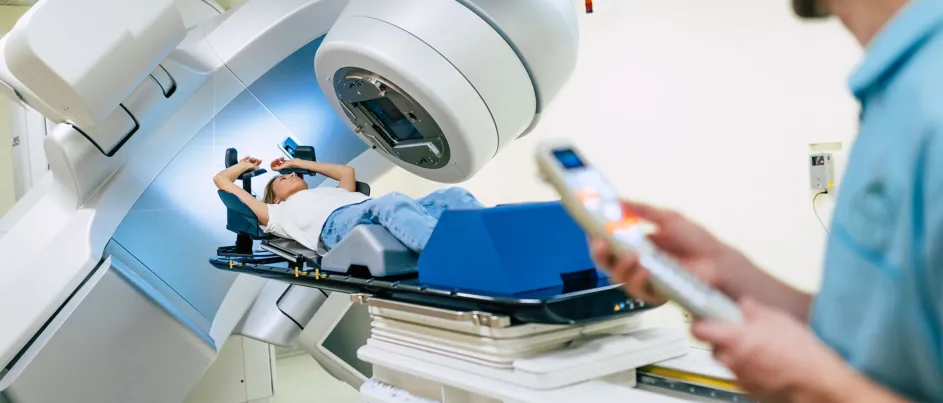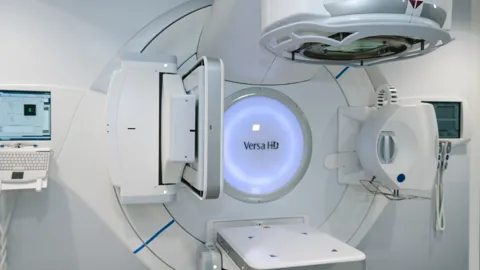Radiotherapy

Radiotherapy (also called ‘radiation therapy’) treats cancer by using radiation to destroy cancer cells. It is a non-invasive treatment and is commonly done as an outpatient. Radiation can be targeted to where the cancer is in the body. Special techniques are used to minimise dose (and hence harm) to surrounding normal body tissues.
Not everyone who has pancreatic cancer will have radiotherapy. However, research is showing that radiotherapy before surgery may help shrink the cancer so that it can be completely removed at surgery.
In certain cases, radiotherapy may also be given after surgery to help stop the cancer coming back. Radiotherapy can also be used as a palliative treatment to help control symptoms such as pain or bleeding from either the pancreatic cancer or from metastases elsewhere.
What to expect
Radiation before or after surgery is usually given on five consecutive days for five to six weeks. The treatment only takes about 15‒20 minutes each time and it is not painful. It is often combined with chemotherapy (which may be in the form of tablets taken each day during treatment).
Palliative treatments are usually much shorter and often involve one to five treatments.
Before starting your radiotherapy, you will meet with a radiation oncologist and nurses who will explain your treatment in detail with you. You will need to have a scan prior to starting your treatment to create your radiation plan. This is called simulation and typically takes one hour to do. A radiation therapist and nurses will support you through this session. At this appointment you will have small dots of ink placed on your body which are permanent. These are used each day to ensure you are in the exact position for your treatment.
When receiving treatment to the pancreas area, many people have some degree of nausea, abdominal discomfort and fatigue, which tends to get worse towards the end of treatment and settles a few weeks afterwards. It may help to have someone drive you to and from your appointment each time.
You won’t be radioactive after your treatments, so you are not a risk to anyone else. There may be a risk of late side effects, which your radiation oncologist will discuss with you.

A medical linear accelerator (LINAC) is the most commonly used machine for delivering external beam radiotherapy to people with cancer. It gives high-energy x-rays or electrons to the area where the tumour is.
There are new radiation techniques being used in some treatment centres.
Magnetic resonance image guided radiotherapy (MRIgRT) combines high-resolution magnetic resonance imaging (MRI) techniques with extremely precise radiotherapy. This technology allows your treatment to be changed or adapted everyday based on any changes in position of your internal organs.
Stereotactic radiotherapy (SRT) delivers a higher individual dose of radiation within a shorter timeframe, commonly over 5 treatments and is being more commonly used to treat pancreatic cancer.
Speak with your radiation oncologist about the most appropriate radiotherapy for you.
I had radiotherapy for pain management which helped a lot.
- Lynne
Side effects of radiotherapy
Radiotherapy can cause side effects both during and after the treatment. Some will disappear within a few weeks once the course of treatment has finished. But others can continue for a while after.
The types of side effects depend on where in the body you are having the treatment. For example, if you are having radiotherapy to your abdominal area, you may experience diarrhoea, nausea and vomiting. Tell your radiotherapy nurse if you are having side effects. Nausea and vomiting can be controlled with anti-sickness medications. Other possible side effects can include:
- tiredness and fatigue, which can last for many weeks after treatment finishes
- skin changes such as redness, peeling and soreness are rare side effects.
Your radiation oncologist and nurses will explain about the side effects to expect from your radiotherapy and suggest ways to manage them.
Always consult your doctor or health professional about any health-related matters. Pankind does not provide medical or personal advice and is intended for general informational purposes only. Read our full Terms of Use.
Thank you to the clinicians, researchers, patients, and carers who have helped us create and review our support resources, we could not have done it without you.
